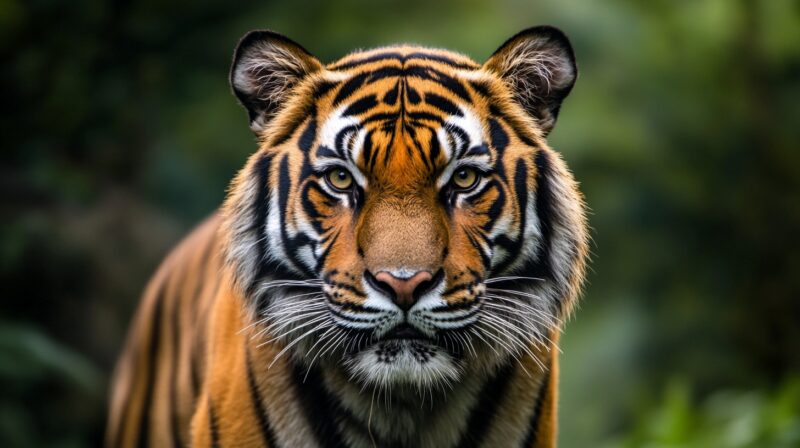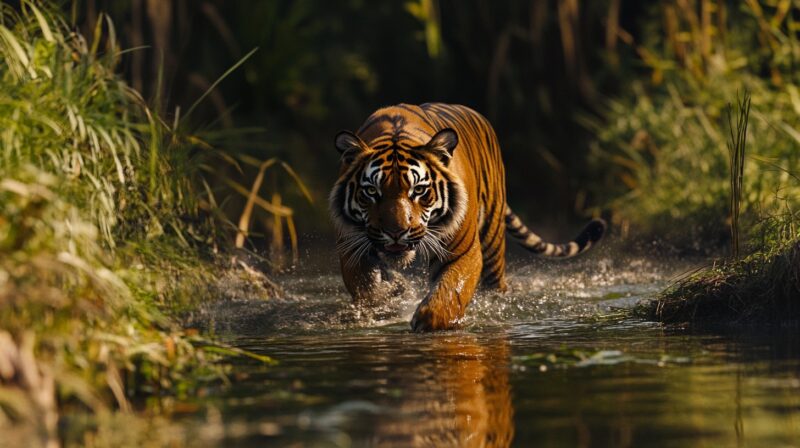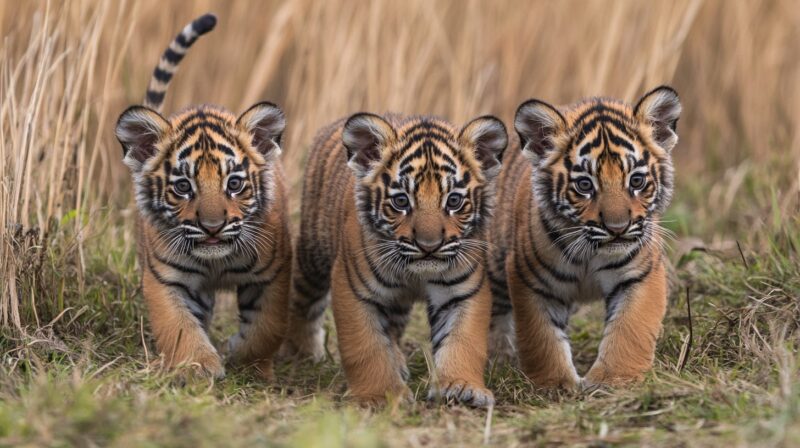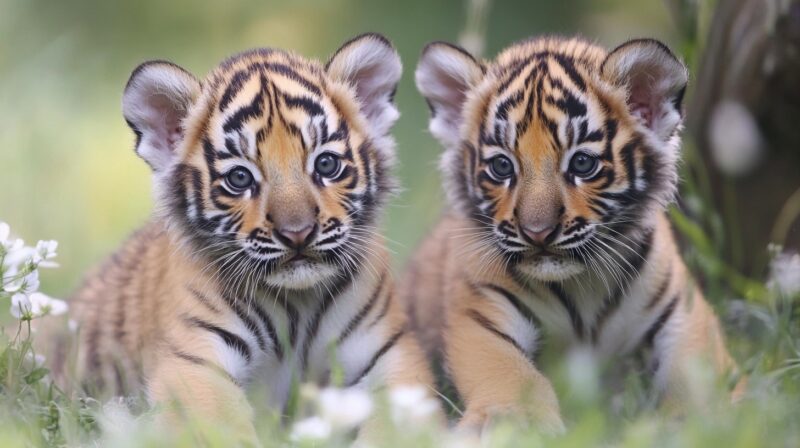The Bengal tiger (Panthera tigris tigris) is the most iconic and widely recognized of all tiger subspecies. Known for its striking orange coat with black stripes, it plays a vital role in the ecosystems it inhabits.
The majority of the wild Bengal tiger population is concentrated in the dense mangrove forests of the Sundarbans, a unique and ecologically rich region that straddles the border between India and Bangladesh.
In addition to the Sundarbans, Bengal tigers also inhabit other regions, including the dense forests and grasslands of Nepal and Myanmar (Burma). Despite their wide range, the Bengal tiger population faces significant threats due to habitat loss, poaching, and human-wildlife conflict.
As one of eight recognized tiger subspecies, the Bengal tiger plays a crucial role in conservation efforts aimed at preserving this majestic species for future generations.
| Attribute | Details |
|---|---|
| Family | Felidae |
| Length | 2.7 to 3.1 m (including tail) |
| Height at shoulder | 91 cm |
| Weight | 180 to 250 kg |
| Sexual maturity | 3 to 5 years |
| Lifespan | 15 years |
- Pale orange fur marked with bold dark stripes
- Sharp, retractable claws
- Incredibly strong jaws
- Exceptional night vision
Extensive Territory
The Bengal tiger, known for its solitary nature, establishes large territories that it marks using scent glands, leaving odorous secretions to warn other tigers to stay away.
The size of its territory is heavily influenced by the availability of prey, with areas rich in food sources requiring smaller territories, while regions with scarce resources necessitate much larger hunting grounds.
The Bengal tiger often needs an expansive living space, which can extend beyond 100 square kilometers, allowing it to roam freely in search of prey and maintain dominance within its range.

Habitat
The Bengal tiger thrives in a wide range of wooded environments, showcasing its adaptability to different ecosystems. It is commonly found in dense jungles, tropical rainforests, and the mangrove swamps of the Sundarbans.
These habitats offer plenty of cover and abundant prey, ideal for the Bengal tiger’s solitary hunting style.
In addition to these lowland areas, Bengal tigers can also be found in higher elevations, particularly in the alpine forests located in the foothills of the Himalayas. Here, the colder climate and diverse terrain present a stark contrast to the warmer, tropical environments they also inhabit.
The versatility in habitat allows the Bengal tiger to survive in various regions across India, Bangladesh, Nepal, Bhutan, and Myanmar, demonstrating their remarkable ability to adapt to both dense forests and open grasslands.
Agile and powerful

Agile and powerful, the Bengal tiger possesses an incrediblely muscular and flexible body, enabling it to excel in various physical feats. Its strength and agility make it an exceptional jumper, capable of leaping nearly 10 meters in a single bound, allowing it to close in on prey or navigate its forested habitat with ease.
On solid ground, the Bengal tiger can achieve impressive speeds, sprinting at up to 60 kilometers per hour, but only over short distances due to the immense energy required for its powerful strides.
Unlike many other felines, the Bengal tiger’s substantial weight restricts its ability to climb trees with the same ease as smaller cats. Despite this limitation, it compensates with other remarkable skills. Notably, Bengal tigers are excellent swimmers, often traversing rivers and lakes in their natural habitats.
The ability is especially crucial in regions like the Sundarbans, where water plays a significant role in the landscape.
Tigers have been observed swimming for several kilometers at a time, making them unique among big cats for their affinity for water.
Lightning-fast attack
The Bengal tiger is a master of stealth, silently stalking its prey with remarkable patience and precision. When the moment is right, it launches a lightning-fast attack that leaves little chance of escape for its victim.
Using its powerful jaws, the tiger can either deliver a bone-crushing bite to the spine, paralyzing or killing the prey instantly, or clamp down on the throat to suffocate it. The force and speed of the attack are often fatal within moments.
Despite its large and muscular build, this formidable predator typically needs only about 6 kilograms of meat per day to sustain itself. However, in times of abundance, it will consume more and stash excess food in hidden locations, allowing it to return and feed again later.
It is an efficient approach to hunting and feeding ensures the tiger maximizes its energy expenditure while securing enough food to survive in its often harsh environment.
Nocturnal hunter

The Bengal tiger is a powerful nocturnal predator with specialized hunting habits.
- Disease
- Injury
- Old age
Though its diet primarily consists of larger animals, it is not averse to taking advantage of smaller prey when the opportunity arises.
- Primary prey: Bengal tigers favor deer species, such as chital and sambar, as well as various types of bovines, including gaur and water buffalo.
- Opportunistic feeder: While its preference is for larger animals, the Bengal tiger will also hunt smaller mammals, birds, or reptiles when available.
- Feeding habits: Among felines, the Bengal tiger is distinctive in its ability to consume meat that has started to decompose, allowing it to scavenge when fresh prey is scarce.
Short-lived relationships
Bengal tigers form temporary mating pairs that last only for the short duration of the breeding period, typically three to seven days. During this time, males are drawn to females in heat by a distinct scent that signals their fertility.
When multiple males compete for the attention of the same female, physical confrontations are rare; instead, these rivalries are usually settled through intimidation displays, such as:
- Growling
- Roaring
- Posturing to avoid serious injury
Once the mating is complete, the male leaves the female and returns to his territory. The female, now pregnant, is left to raise any resulting offspring alone, as Bengal tigers do not form permanent bonds or provide paternal care.
Cubs and Early Development

After a gestation period of approximately 15 weeks, a tigress gives birth to a litter of two to four cubs. At birth, each cub weighs just around 1 kilogram, making them incredibly vulnerable during their early days.
- Birth and Early Days: The cubs are born blind, with their eyes remaining closed for the first 10 days of life. During this time, they are entirely dependent on their mother for warmth, protection, and nourishment.
- First Steps Towards Independence: Around the age of two months, the mother begins to introduce her cubs to solid food by offering small portions of meat. This transition is crucial as it prepares the cubs for life beyond milk feeding.
- Weaning Period: By the time they reach six months old, the cubs are typically weaned off their mother’s milk. At this stage, they start relying more on meat as their primary source of nutrition, though they remain close to their mother for protection and guidance.
- Learning to Hunt: Although they are weaned by six months, young tigers do not begin hunting on their own until they are about 1.5 to 2 years old. During this period, they closely observe their mother’s hunting techniques, learning essential survival skills.
The tigress plays a critical role in the cubs’ development, teaching them the skills necessary to survive in the wild, such as hunting, territorial defense, and recognizing danger.
The cubs typically stay with their mother until they are 2 to 3 years old, after which they leave to establish their territories.

Into adulthood
By the time a tiger reaches one year of age, it has developed its adult teeth, enabling it to begin hunting independently. At this stage, it can pursue smaller prey, gradually honing its hunting skills through trial and experience.
Over the next year, the young tiger undergoes significant physical growth, reaching a weight between 150 and 200 kg.
The increased size and strength allow it to tackle larger prey, such as deer, wild boar, and even buffalo, depending on the available species in its habitat.
Between the ages of two and three years, the tiger reaches full adulthood, both physically and behaviorally. During this time, it typically separates from its mother to establish its own territory. The process of claiming a territory is essential for survival, as tigers are solitary animals that require large hunting grounds to sustain themselves.
The size of the territory can vary depending on factors such as the availability of prey and competition from other tigers.
Male tigers often seek larger territories, which may overlap with the ranges of several females, while females tend to establish smaller, more exclusive territories.
Threats

Over the course of less than a century, three of the original tiger subspecies have been driven to extinction, a stark reminder of the vulnerabilities faced by these majestic predators.
The Bengal tiger experienced a dramatic decline as well.
Between 1900 and 1972, the population of Bengal tigers dropped drastically, falling from an estimated 40,000 to 50,000 individuals to fewer than 3,000.
This catastrophic decline was largely driven by habitat destruction, rampant poaching, and human-wildlife conflict.
Tigers were hunted for their skins, bones, and other body parts, highly valued in the illegal wildlife trade, especially for traditional medicines.
The loss of habitat, caused by deforestation and agricultural expansion, further compounded the issue. Tigers require vast territories to survive, and as their habitats were fragmented or destroyed, their prey base dwindled, pushing the animals closer to human settlements, where they often came into conflict with people.
Read More: Find out everything there is to know about Canada Goose, who knows when you might need that info!







